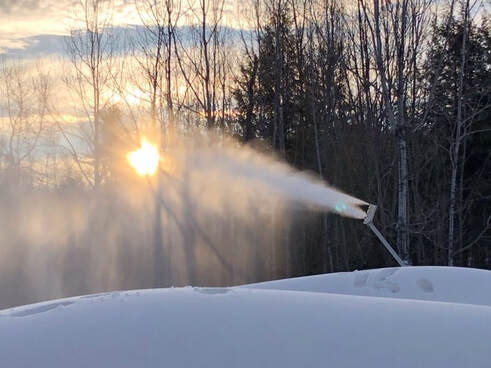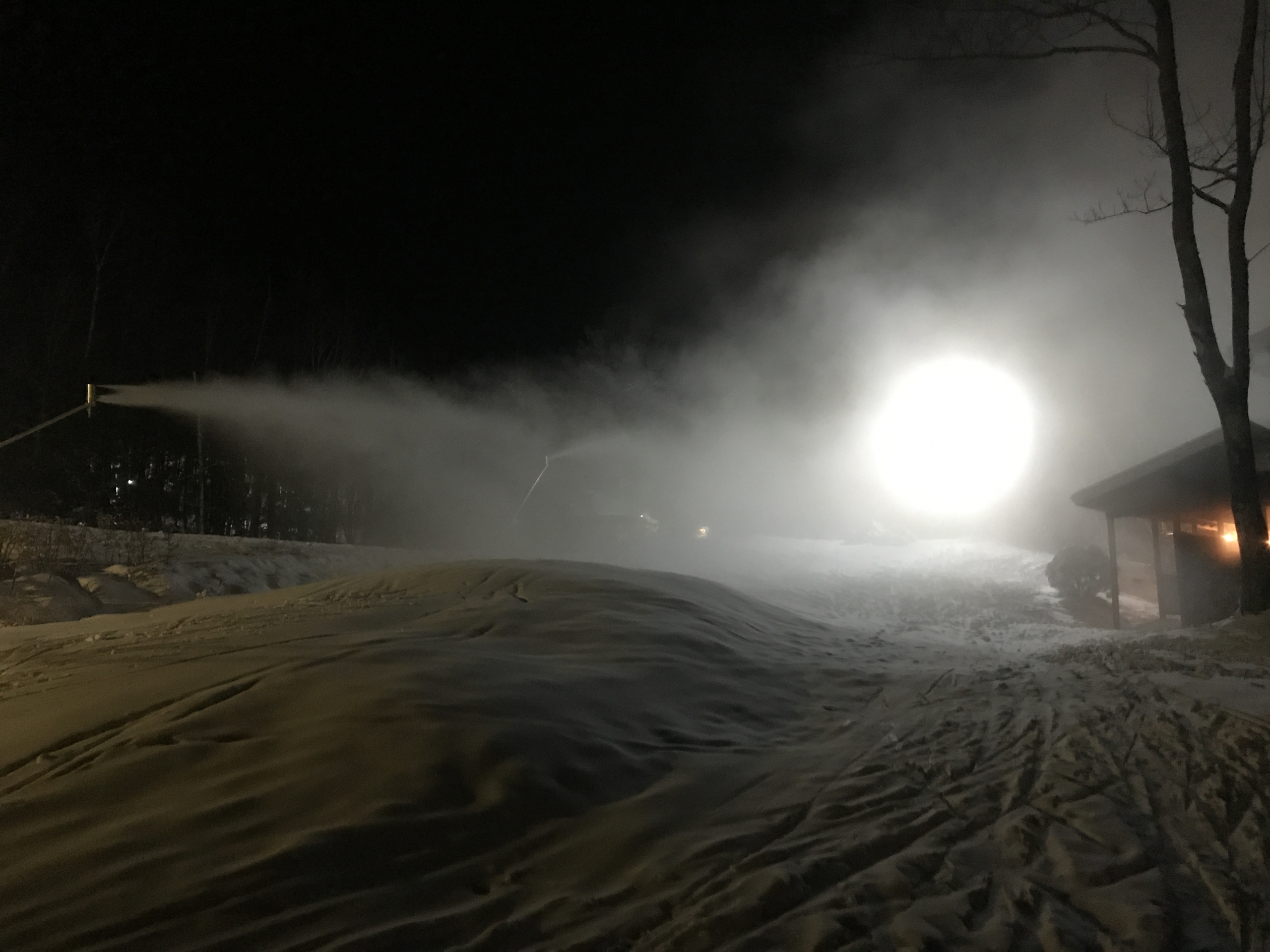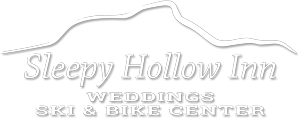Snowmaking Components and Costs at
Sleepy Hollow Inn, Ski and Bike Center

Snowmaking Components and Costs at Sleepy Hollow Inn, Ski and Bike Center
SNOWMAKING PROJECT: We started snowmaking in the winter of 2012 to improve the skiing experience here at Sleepy Hollow. 2011/12 year was very poor natural snow year (27 days open), so it was time to install snowmaking. The first year we had a 700 meter loop, then we added pipe and more snow guns in the following years to build up to a 1.2km loop (2014-2017). We got up to a 2km snowmaking loop (2018-2021). And now are up to 2.5km (2022-). Making snow is a challenging endeavor with breakdowns, meltdowns, freeze ups and late nights. But it has totally been worth it as the skiing is much more consistent and reliable.
2023 snowmaking update:
- Tested a 10 mini gun sled design this winter with mostly good results. 3 x 100 foot sections connected by camlock fittings. Guns flopped over a bit so we had to prop them up, so we need to figure out that better for next year.
- Bought new tripod mounted Phazer (similar to our 3 SV5 guns). Put it to good use right away.
- 2023/24 by the numbers: 3 x SV5 snowguns, 1 x SV10 snowgun, 1 x phaser, 1 water only Ratnik H2 snowgun, 1 x 15hp rotary screw compressor, 1 x 10hp, 2 x 7.5hp, 2 x 5hp reciprocating air compressors, 3 x 7.5hp water pumps (30gpm each). 1.5 million gallons water used this year. 30,800 kwh electricity used ($5700 in electricity cost).
2022 snowmaking update:
- Fabricated 16 mini guns for this year. We basically took the 1 of 2 nozzles from an HKD phaser gun (2.9 gpm water, 5cfm air per nozzle) and machined and welded (thanks John!) into a mini gun. We then made up mini hydrant runs, with 2 x 16 hydrant sets on Potato Farmer, 15 hydrant sets on Acadia Mania, 15 hydrant sets on Butternutter lower, 14 hydrant sets on Butternutter upper, and 10 hydrant sets on Ridge Road. For each line of hydrant sets, we set up the guns using camlock fittings on a vertical water and air pipe. As of early January, the system is working great. The biggest advantage is smaller more frequent snow piles that are easier to push out with our pistenbully.
- Ordered new 15hp rotary screw air compressor so we can run more guns, also added 3rd well pump so we can now pump at 90 gpm rate.
2020 & 2021 snowmaking updates:
- Experimented with water only system suspended 20′ above trail in 2020. Mist nozzles every 20′ using dr9 hdpe pipe and high tension wire. 50% success rate, decided not to expand/pursue this type of system. Need 5 degrees F or colder and not enough of those nights early in season. Also made icier mix.
- Also experimented with air/water mini guns from a home snowmaking online kit in 2021. Had icing issues with the air and water pressure we were using. Not going to expand this type of system either due to icing issues.
- Prototyped another type of air/water mini system in Feb.2022. Seems to work great! Plan to use this system with a gun every 40 feet along Potato Farmer trail for 2022/23 winter.
- Calculated energy use for last 2 years. About 22,600kwh used for each winter. This costs about $3770 in electricity cost each year.
As of fall 2019 here is what we’ve got for a system:
- About 1000 meters of steel water pipe, 650 meters of DR 7 HDPE black poly water pipe, and 1800 meters of plastic HDR11 black poly pipe for our compressed air. We have 25 hydrant sets (a place to connect the snow guns into the air and water supply).
- We have 2 x 7.5 hp water pumps (can pump 60 gallons per minute at about 400psi)
- We have 4 HKD air water guns ( 1 x SV10 HKD, 1 x SV5 HKD, and 2 x Phazer HKD) plus one water only Ratnik H2 Snow gun (2019)
- We have a 2 KM snowmaking loop averaging 12″-24″ deep. We usually start making snow in mid to late November. We need temperatures below 27 degrees to start up the guns.
- For the 2018/2019 snowmaking season we used 16,228 Kwh of electricity to produce our 2km snowmaking loop. Which at $.16 per kwh, works out to about $2600 of electricity costs. (Notes: We solar net metered most of that electricity… and it was a colder than normal period for snowmaking, which led to reduced costs over a more normal winter).
SNOWMAKING COMPONENTS AND COSTS:
When we started this project, there weren’t too many nordic areas doing it yet. There was also a dearth of online information about making snow for nordic areas and the costs involved. This description is here for those curious about snowmaking, and for those that are considering putting in their own systems and need some internet resources… Here is what we spent to make this project happen, so that other ski areas and enthusiasts can see what it takes to get started. Here are the components and costs involved years 2012-2015.
- 500′ of 6″ used steel pipe with plastic coating, 1500′ of 2″ used steel pipe, welding of the pipe, 3 x hydrant sets, pump platform in pond, etc. = $43,000.00.
- This was our “we don’t know what we’re doing, let’s hire professionals” phase of our snowmaking adventure.
- Electric upgrades (extension of high voltage single phase line (300 amps), fuse protection, wiring to pumps, etc.) = $21,000.00
- 1 x SV10 & 1 x SV5 snow gun with aluminum sled. 600′ of snow hose, 3 x water hydrants. = $12,500.00
- 2 x 3 phase 7.5 hp water pumps with 2 x phase converters, fish screens = $10,500.00
- 1 x 10 hp single phase air compressor. 35 cfm at 100 psi, and 1 x 7.5hp single phase air compressor 23 cfm at 100psi = $8,200.00
- Welding in 2014. = $4500
Here are the components and costs involved year 2016 upgrades:
We’re essentially doubling our piping layout to make it easier to make snow (more convenient hydrants = less lugging snowmaking hose around!)… We’re doing this by taking all our metal air pipe and moving/changing it to water pipe. We then bought DR11 black poly pipe that we’ll bury to make our compressed air lines. We’re also burying some pipe that has been exposed until now for better freeze protection.
- 1 x Phazer snow gun with sled, plus 5 x water hydrants. = $6,500.
- 3000 feet HDR11 black poly pipe (for compressed air). = $2,900.
- Tools and fittings to socket weld poly pipe. = $2,000.
- 5hp 17 cfm air compressor and installation. = $2,500.
Here are the components and costs for our 2018 upgrades… We wanted to expand our snowmaking loop up to 2km (from 1.2)… We had to make both water storage improvements and extend our snowmaking lines. We decided to add a second water storage pond about 200 meters from our current pond, and connect them via a 1.5″ water pipe. We control the flow via a ball valve that we can close or open to the right flow. We got the permitting by Oct. 20th, 2018, and had to hurry to build the pond before winter. We used our 45 hp excavator, plus our tractor to dig the pond over a week. We were expecting clay hardpan soil, but were surprised to find a seam of gravel in part of the pond area… As a result, we decided to line the pond with 6 mil poly plastic sheeting. It only took 10 days to clear and dig the pond… Then we were worried our intermittent ditches wouldn’t fill the pond up in time… Then it rained really hard, and then we were worried the pond was filling too fast and might blow out the back pond berm (since it was recently excavated material it was more likely to blow out). But all worked fine, and we had a full second pond by the start to the snowmaking season.
We also had to extend our snowmaking lines to cover the new loop additions… We had to extend two lines with 5 hydrants sets each down Liberty Meadow (1000′) and Lower Saddle trail (1000′). I also wanted to experiment and try out hdpe poly pipe for our high pressure water lines…. I liked the fact that I could use socket fusion to weld in the hydrant sets (instead of hiring a welder with metal pipe). I also liked that the lifespan of the hdpe should be a lot longer as hdpe doesn’t rust. There is some online information on using this with bigger diameter pipe (4″ and above at alpine areas), but we were only looking for 2″ pipe. I did some research, and felt good enough about using 2″ dr7 black poly hdpe pipe. It has a pressure rating of 335 psi (at 73 degrees). Our water pressure gets up to 375 psi, but our water temp is always under 40 degrees… So it was a little bit of a risk to run that high pressure in these pipes, but I went for it… and it worked (at least so far…). No blowouts yet… I’ll update if any do fail (Update: No failures to report after the first year!).
Here are our costs:
- 1 x HKD Phazer snow gun (built our own sled to save money… probably should have just bought the sled) , plus 10 x water hydrants, plus 4 x 50′ snowmaking hose = $9,000.
- 1200 feet 2″ DR 7 black poly pipe (for water lines), plus 1500 feet DR 11 black poly pipe (for air lines). = $9000
- Socket fusion fittings to put in hydrant sets, plus hardware to make 10 air hydrant sets. = $1200
- Tools and fittings to socket weld poly pipe. = $200.
- 5hp 17 cfm air compressor and installation. = $2,500.
- Pond construction, plastic sheeting, fuel costs, pipe costs to connect the two ponds (we used our own excavator and tractor to dig the pond so not bad for costs here)… $1,000.
Here are the components and costs for our 2019 upgrades… We had a few improvements we wanted to do in 2019… The first was to add a Ratnik H2 snow gun… This is a water only gun (so no compressed air is used). The mast is 20′ long… In comparison our other snow guns have a 10′ mast. The taller mast allows for greater hang time and dispersion… The water needs to be cold to use this type of gun… Ours is cold as it comes from the top 2′ of our pond which makes it always in the mid to low 30’s. I’ll update on how this new gun works after this season (Update: Works great at 5 degrees or colder. Snow is a little slushy using up to 15 degrees. Leaves huge piles of snow on those really cold nights)… It will be used in our meadow as it should have a wide dispersal. We made our own sled for it. We also added in 700 feet of dr7 poly pipe for water and 500′ for air, as well as 10 more hydrant sets for easier set up times. We also moved our 4th compressor from the pisten bully garage to the round barn basement…. We had problems with water condensation inside the air pipe as it left the pb garage. Condensation kept flowing back downhill and freezing up next to the compressor. Problem solved by moving the compressor.
- 1 ratnik™ H2 Snow Gun. = $3,000.
- 700 ft dr7 pipe and 500 ft dr 11 pipe. = $1,800.
- hydrant set components & misc. fittings. = $1,200.
2022 upgrades:
- 16 miniguns parts and fabrication = $5000.00
- 2000 ft dr 9 2″ water pipe, and 5000 ft dr 9 1.5″ water and air lines = $9000.00
- mini gun hydrant hdpe fittings = $2500
- 3 new 7.5hp well pumps with vfd’s (one of our 10 year old well pumps broke, and we decided to replace other old one plus adding 1 new) = $8000.00
- 1 new 15hp single phase rotary screw air compressor. $9500.00
Total costs 2012 to present: = $176,500.00 (note this cost represents material costs, our labor costs are not included in this).
DISCUSSION: We had several design options to consider, including whether to go with diesel powered air compressors, or electric. We opted to go electric, as we’ll have the capability to offset a lot of our energy usage through net metering with our solar panels. We also liked the air quality and lower sound benefits of going with electric.
We tend to move the guns around during the day, but then we let the snow pile up overnight (as we like our beauty sleep). The next day (or in a few days if we can to let the snow whales drain and freeze) we push the snow around with our Pisten Bully.
Costs to operate the system have been actually lower than I expected… From $400 in electricity costs in 2012, to just over $1000 in 2015 (bigger loop). Now in 2018 we used $2600 in electricity costs. Most all this electricity is covered by our solar panels. There are of course other costs like man hours, and machine hours to push and groom the snow. Our system is definitely on the small side compared with alpine areas, and compared to other nordic areas like Craftsbury and Rikert nordic. It takes a month and a half with decent weather to get our full 2km fully covered… Improvements in future years will include reducing the amount of time it takes to get a full loop covered.
Like many snowmaking operations, there is a lot to go wrong. We have buried our own snowguns (when the wind shifts overnight, you can wake up to the sled of your gun under 3 or 4 feet of heavy wet snow). I’ve then broken the sleds when trying to push it out with the pisten bully. We’ve had frozen pipes… These often take a lot of time to diagnose where the freeze is, and then if it is fixable it takes a lot of time with a torch to unfreeze. Sometimes the metal pipe bursts with frozen water (we lost a 130′ section of metal pipe with the entire pipe froze accidentally in 2017). My favorite recent story (from 2018)… I was trying to get past a snow whale on the snowmobile (big snow pile created when gun left running for 8+ hours in one place). I got partially over the whale, slid off the side of the trail, and got the snowmobile stuck in a ditch… I goosed the throttle several times and spun the track of the snowmobile to try to get unstuck… I didn’t even realize I was directly over the air line when I did this, and sure enough the studded track of the snowmobile clawed right through the air line. Compressed air started hissing out, and after a few swear words and an ill fated repair attempt, I had to shut down all 4 guns that night due to no air pressure. The next day I was able to repair the section by splicing in a 2′ new pipe section. Live and learn.
Another story from 2019… Dave accidentally hooked a snowmaking hose while he was grooming a trail with our ATV groomer. The hose pulled the water hydrant out of the 6″ metal pipe and a nice water geyser happened! Luckily the hydrant broke off above the fitting, so we were able to get in there with a pipe wrench, remove the remaining hydrant section from the 6″ pipe, and thread in another water hydrant. The whole repair took only about an hour.
Old posts below…
Update: As of 1/26/13, we’ve used 2500 kwh of electricity to make our 700 meter loop. If the electricity costs us $.16 per kwh, our total electricity expenditure would be $400.00. Aside from burying the snowgun sled a few times, and an air line freeze up, so far so good.
Update #2: As of 11/22/13 we’ve installed another 900′ of 2″ steel pipe. 300′ of pipe extends us to the middle of Molly’s Meadow for better coverage there. The other 600′ extends down Liberty Meadow Trail for coverage of that part of our lighted loop.
Update #3 as of 4/1/15 This year’s energy use for our 1.2km loop is: 6615kwh which equals $1060.00 in electricity charges… Much of this cost is offset by our solar panels, however.
Update #4 winter 2019/2020… Just calculated electricity usage for the snowmaking “season”… Looks like 21,500 kw used, which works out to about $3700 in electricity costs to make our 2 km snowmaking loop.







